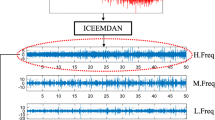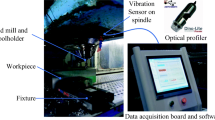Abstract
In metal cutting processes, the chatter may cause fast wear of tools and poor surface quality of the processed parts; it can happen on different cutting parameters, but how do we identify the chatter and how do we select suitable cutting parameters to avoid chatter at high material removal rate (MRR). In this paper, the signal processing methods such as time domain, frequency domain, and time–frequency domain analysis are introduced. The signals of cutting force that were collected in milling titanium alloy Ti–6Al–4V at variable cutting speeds varied from 80 to 360 m/min; signal analysis methods such as time domain, frequency domain, and time–frequency domain were put forward. Further analysis results reveal that the chatter occur when cutting speeds are 240 and 360 m/min, when the maximum value of cutting forces increase by 61.9–66.8%, the standard deviation increase by 84.1–86.1%, and the surface roughness increase by 34.2–40.5% compared with that of at 80 m/min. Detail signal d2 is employed to monitor cutting stability state from the result of wavelet analysis.
Similar content being viewed by others

References
Duncan GS, Tummond MF, Schmitz TL (2005) An investigation of the dynamic absorber effect in high-speed machining. Int J Mach Tool Manuf 45:497–507
López de Lacalle LN, Pérez-Bilbatua J, Sánchez JA, Llorente JI, Gutiérrez A, Albóniga J (2000) Using high pressure coolant in the drilling and turning of low machinability alloys. Int J Adv Manuf Technol 16:85–91
Lopez de Lacalle LN, Perez J, Llorente JI, Sanchez JA (2000) Advanced cutting conditions for the milling of aeronautical alloys. J Mater Process Technol 100:1–11
Ezugwu EO, Wang ZM (1997) Titanium alloys and their machinability—a review. J Mater Process Technol 68:262–274
Sun S, Brandt M, Dargusch MS (2009) Characteristics of cutting forces and chip formation in machining of titanium alloys. Int J Mach Tool Manuf 49:561–568
Basturk S, Senbabaoglu F (2010) Titanium machining with new plasma boronized cutting tools. CIRP Ann Manuf Technol 59:101–104
Sun J, Guo YB (2009) Material flow stress and failure in multiscale machining titanium alloy Ti–6Al–4V. Int J Adv Manuf Technol 41:651–659
Chen G, Ren CZ, Yang XY, Jin XM, Guo T (2011) Finite element simulation of high-speed machining of titanium alloy (Ti–6Al–4V) based on ductile failure model. Int J Adv Manuf Technol 56:1027–1038
Rahman M, Wang ZG, Wong YS (2006) A review on high-speed machining of titanium alloys. Jpn Soc Mech Eng Intern J 49(1):11–20
Al-Zaharnah IT (2006) Suppressing vibrations of machining processes in both feed and radial directions using an optimal control strategy: the case of interrupted cutting. J Mater Process Technol 172:305–310
Armando ISA, Anselmo ED, Robson P (2010) Vibration analysis of cutting force in titanium alloy milling. Int J Mach Tool Manuf 50:65–74
Liao YS, Young YC (1996) A new on-line spindle speed regulation strategy for chatter control. Int J Mach Tool Manuf 36(5):651–660
Lee BY, Tarng YS (1999) Milling cutter breakage detection by the discrete wavelet transform. Mechatronics 9:225–234
Li XL, Guan XP (2004) Time-frequency-analysis-based minor cutting edge fracture detection during end milling. Mech Syst Signal Process 18:1485–1496
Cao HR, Chen XF, Zi YY, Ding F, CheHX TJY, He ZJ (2008) End milling tool breakage detection using lifting scheme and Mahalanobis distance. Int J Mach Tool Manuf 48:141–151
Kim JS, Kang MC, Ryu BJ, Ji YK (1999) Development of an on-line tool-life monitoring system using acoustic emission signals in gear shaping. Int J Mach Tool Manuf 39:1761–1777
Huang PL, Li JF, Sun J, Song LY (2010) Vibration analysis in high speed machining titanium alloy with solid cemented carbide end mill. Mater Sci Eng Powder Metall 15:574–579
Huang PL, Li JF, Sun J, Ge MJ (2012) Milling force vibration analysis in high-speed-milling titanium alloy using variable pitch angle mill. Int J Adv Manuf Technol 58(1):153–160
Yao ZH, Mei DQ, Chen ZC (2010) On-line chatter detection and identification based on wavelet and support vector machine. J Mater Process Technol 210:713–719
Schmitz T, Medicus K, Dutterer B (2002) Exploring once-per-revolution audio signal variance as a chatter indicator. Mach Sci Technol 6:207–225
Cao HR, Chen XF, Zi YY, Ding F (2008) End milling tool breakage detection using lifting scheme and Mahalanobis distance. Int J Mach Tool Manuf 48:141–151
Li XL (2001) Detection of tool flute breakage in end milling using feed-motor current signatures. ASME Trans Mechatron 6:491–498
Li WH, Gong WG (2005) A method of recognizing tool-wear states based on a fast algorithm of wavelet transform. J Mater Process Technol 170:374–380
Zhu KP, Wong YS, Hong GS (2009) Wavelet analysis of sensor signals for tool condition monitoring: a review and some new results. Int J Mach Tool Manuf 49:537–553
Author information
Authors and Affiliations
Corresponding author
Rights and permissions
About this article
Cite this article
Huang, P., Li, J., Sun, J. et al. Vibration analysis in milling titanium alloy based on signal processing of cutting force. Int J Adv Manuf Technol 64, 613–621 (2013). https://doi.org/10.1007/s00170-012-4039-x
Received:
Accepted:
Published:
Issue Date:
DOI: https://doi.org/10.1007/s00170-012-4039-x



